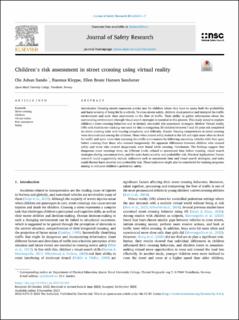| dc.contributor.author | Sando, Ole Johan | |
| dc.contributor.author | Kleppe, Rasmus | |
| dc.contributor.author | Sandseter, Ellen Beate Hansen | |
| dc.date.accessioned | 2024-04-08T07:02:33Z | |
| dc.date.available | 2024-04-08T07:02:33Z | |
| dc.date.created | 2023-11-06T10:15:48Z | |
| dc.date.issued | 2023 | |
| dc.identifier.citation | Journal of Safety Research. 2024, 88 (February), 1-7. | en_US |
| dc.identifier.issn | 0022-4375 | |
| dc.identifier.uri | https://hdl.handle.net/11250/3125178 | |
| dc.description.abstract | Introduction: Crossing streets represents a risky task for children where they have to assess both the probability and harm severity of being hit by a vehicle. To cross streets safely, children must perceive and interpret the traffic environment and scale their movements to the flow of traffic. Their ability to gather information about the surrounding environment through visual search strategies is essential in this process. This study aimed to explore children's street crossing behaviors and to identify successful risk-assessment strategies. Method: Virtual reality (VR) with built-in eye tracking was used for this investigation; 55 children between 7 and 10 years old completed six street crossing tasks with varying complexity and difficulty. Results: Varying competencies in street crossing were demonstrated among the children. Those who crossed safely looked to the left and right more often to check for traffic and spent more time assessing the traffic environment by following oncoming vehicles with their gaze before crossing than those who crossed dangerously. No apparent differences between children who crossed safely and those who crossed dangerously were found while crossing. Conclusions: The findings suggest that dangerous street crossings were, on different levels, related to assessment time before crossing, visual search strategies during assessment time, and the tasks harm severity and probability risk. Practical Applications: Future research could suggestively include indicators such as assessment time and visual search strategies, and tasks could discern harm severity and probability risk. These indicators might also be considered for training programs aiming to enhance children's pedestrian safety. | en_US |
| dc.language.iso | eng | en_US |
| dc.rights | Navngivelse 4.0 Internasjonal | * |
| dc.rights.uri | http://creativecommons.org/licenses/by/4.0/deed.no | * |
| dc.title | Children's risk assessment in street crossing using virtual reality | en_US |
| dc.title.alternative | Children's risk assessment in street crossing using virtual reality | en_US |
| dc.type | Peer reviewed | en_US |
| dc.type | Journal article | en_US |
| dc.description.version | publishedVersion | en_US |
| dc.rights.holder | ©2023 Forfatterne | en_US |
| dc.source.pagenumber | 1-7 | en_US |
| dc.source.volume | 88 | en_US |
| dc.source.journal | Journal of Safety Research | en_US |
| dc.source.issue | February | en_US |
| dc.identifier.doi | 10.1016/j.jsr.2023.10.002 | |
| dc.identifier.cristin | 2192427 | |
| cristin.ispublished | true | |
| cristin.fulltext | original | |
| cristin.qualitycode | 1 | |

